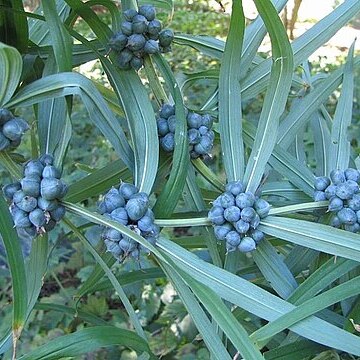Rhizome moniliform or tuberous terete, 1--2 cm thick. Stem erect or scandent, 30--90 cm, glabrous. Leaves in whorls of 3--6, rarely also a few alternate in proximal part of stem, sessile, narrowly linear to linear-lanceolate, very rarely oblong-lanceolate, 4--9(--12) cm × 2--8(--15) mm, apex usually cirrose at anthesis. Inflorescences usually 2-flowered; peduncle 3--10 mm; bracts 1--2 mm, scarious, veinless, or bract absent. Flowers pendulous; pedicel 3--8 mm. Perianth white, greenish, or pale purple, subcylindric, slightly constricted in middle, 8--11 mm; lobes ca. 2 mm. Filaments 0.6--0.8 × ca. 0.15 mm, papillose; anthers 2--2.5 mm. Ovary ca. 2.5 mm. Style ca. 2 mm. Berries red or purple-red, 8--9 mm in diam., 4--9-seeded. Fl. May--Jul, fr. Sep--Oct. 2 n = (20*, 24*), 30* (38).
More
A herb. It grows to about 1-2 m high. The stem is grooved. The leaves do not have leaf stalks. The leaves occur in rings of 3-6. They are 12-16.5 cm long and 0.2-0.7 cm wide. They are narrow and sword shaped. They are curled at the tip. The edges of the leaves are rolled in. The flowers are white. They are arranged as equal stalks flowers along a stalk. The fruit are red berries.

